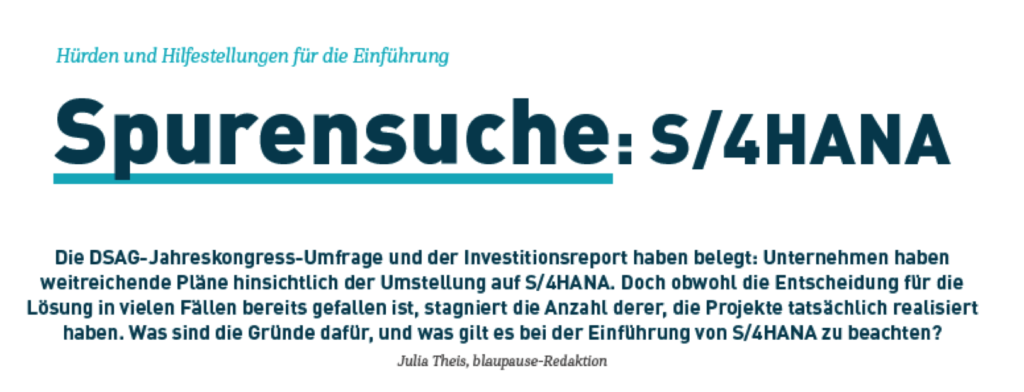Abstract: DSAG deals with issues surrounding the introduction of S/4HANA and offers a comprehensive range of information on this topic. This blog post provides an overview of the contributions and tools used to address DSAG’s topics.

 DSAG’s “blueprint” recently published an excellent article on the difficulties companies face when converting to S/4HANA and on what needs to be taken into account during the introduction. I would like to take this opportunity to point out that we have dealt with many of the aspects addressed in the article in various articles here in our blog (at www.sapxp.ch) and thus make the relevance of all these points clear to you once again.
DSAG’s “blueprint” recently published an excellent article on the difficulties companies face when converting to S/4HANA and on what needs to be taken into account during the introduction. I would like to take this opportunity to point out that we have dealt with many of the aspects addressed in the article in various articles here in our blog (at www.sapxp.ch) and thus make the relevance of all these points clear to you once again.
Greenfield or brownfield approach?
Lack of experience on the part of companies AND consultants is a recurring theme and one of the reasons why our blog exists at all. We cover both the greenfield and the brownfield approach, which assumes an existing SAP R/3 ERP system. This especially in:
- Blog post 16 (Licensing)
- Blog post 8 (Free tools for S/4HANA)
- Blog post 9 (SAP Model Company or own Model Company?)
- Blog post 10 (Setting up your own model company)
- Blog post 11 (Mapping of Best Practice Processes in the BPML)
Information on project organization
I have also heard complaints more than once about SAP’s lack of information on the introduction of – or conversion to – S/4HANA. This is why we have posted our blog post 12, for example, entitled: “How can I set up my project organization in a process-oriented manner and map necessary integration aspects and overarching tasks in a meaningful way?”
The next two posts follow on directly from this and offer an “Overview of the most important project management processes to be implemented and some tips on how to deal with them pragmatically”, divided into blog post 13 (time and resource planning) and blog post 14 (scope, problem/risk and decision management).
Project objectives and control
In my opinion, the blueprint article also mentions with good reason the necessity for companies to ask themselves some important, fundamental questions about the project objectives before implementation, the complexity of which is often underestimated. Our blog post 3 (Basics and Principles) and blog post 4 (Aspects of Project Goals) deal with these questions respectively: In “Basics and principles – too banal and self-evident?” we deal with these questions:
- What should be achieved? (Project objectives in all aspects)
- How is this to be achieved? (Project implementation in all aspects)
- How is it ensured that the right result is achieved? (project controls)
“Aspects of the project objective – the way to the full description of the desired project result” then highlights the most important areas of project management in the implementation project.
Partnering models
Just as difficult is the question of selecting business partners. We have dedicated a contribution to this topic as well: Blog post 5 provides a structured overview of the important questions concerning “Partnering models, the contractual set-up for cooperation with external experts and consulting firms”.
Public Cloud, Single Tenant Cloud or On-Premise System?
Last but not least, the design of the infrastructure in which the upcoming system will exist should not be forgotten. Outsourcing in the Coud, On-Premise, or, or, or? Here, too, a few things need to be taken into account early on in the planning process. Our blog post 17, “What is the difference between the available operating options – public cloud, single-tenant cloud, on-premise system?”, brings light into the darkness here too.
The DSAG article also addresses data migration in passing. We will publish a blog article on this important topic in the coming weeks.
Fundamental questions as a preliminary project
In the DSAG article, it is recommended to clarify fundamental questions before the start of the actual S/4HANA implementation project within the framework of an upstream project. In the project currently managed by me, we did this in the course of a preliminary project lasting almost nine months and compared and evaluated different options in decision papers on more than 60 functional and technical issues and finally submitted them to the steering committee for a decision with a well-founded recommendation for an alternative.
Licenses and functionalities
Now one might think that this should be sufficient – but we have to admit that we should have addressed many more topics in advance. This concerns the new technical possibilities and new licensing issues that we are facing with S/4HANA, but also new or, compared to the R/3 system, no longer existing functionalities. Here I refer in particular to the S/4 HANA 1909 Simplification List mentioned in blog post 8 and recommend in addition to this the detailed study and early decision of the use of the embedded functions newly available in S/4HANA (such as embedded eWM or embedded PPDS); see also blog post 16.
Looking back, I can say that many of the issues raised in the DSAG article at https://blaupause.dsag.de/spurensuche-s4hana have already been addressed in this BLOG, which encourages me to be on the right track here. I will continue my efforts to provide you with valuable support for a successful implementation of your S/4HANA project and I would be happy if you come back again!
